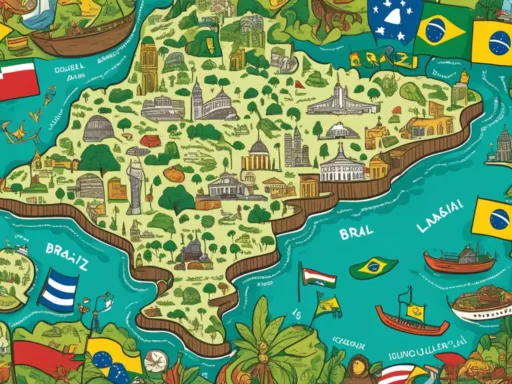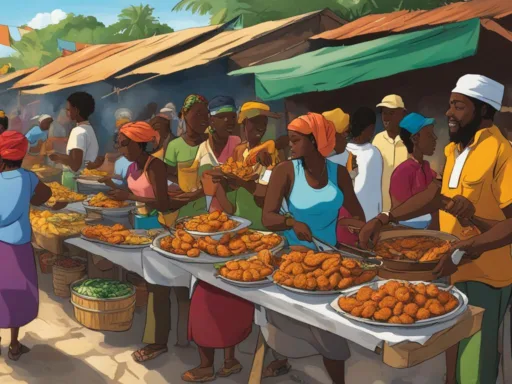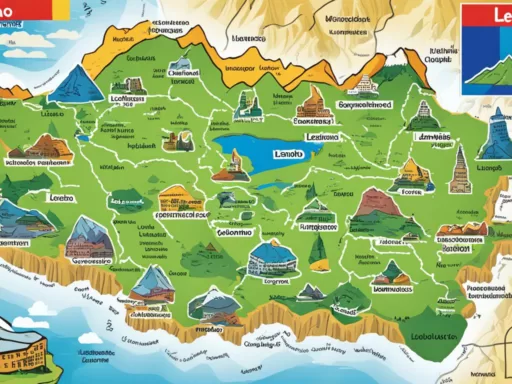Within the folds of Nepal’s dramatic mountain ranges lies an unexpected marvel of diversity—a linguistic mosaic unparalleled in scope. Remarkably, this relatively small country buzzes with over 120 ethnic languages. From the bustling streets of Kathmandu to the serene trails of Everest, melodies of languages resonate, each carrying the heartbeat of Nepal’s rich cultural heritage. Known for linguistic diversity, Nepal not only offers breathtaking natural vistas but also an auditory journey through myriad dialects and languages, capturing the essence of this nation’s multiethnic identity.
As you delve into the linguistic labyrinth of this Himalayan country, you’ll encounter the hum of Indo-Aryan and Sino-Tibetan languages, the whispers of Austroasiatic tongues, and the rare echoes of Dravidian speech. The sheer variety of languages spoken across Nepal’s communities highlights the intense intertwinement of language and cultural identity. Each ethnic language is a trove of stories, traditions, and worldviews, with Nepali emerging as the harmonious thread weaving through the tapestry, connecting diverse ethnic lines within the country.
Key Takeaways
- Nepal is home to an astounding linguistic diversity, with over 120 languages spoken throughout the country.
- Language in Nepal is a direct reflection of the country’s complex ethnic landscape.
- The principal official language, Nepali, bridles the linguistic expanse by serving as a unifier.
- Understanding the languages spoken in Nepal is key to appreciating the country’s rich cultural fabric.
- Nepal’s languages encompass multiple language families, showcasing the historical and cultural legacies of its people.
- The celebration of ethnic languages in Nepal is a cornerstone in the preservation and honoring of its multifaceted identity.
The Dominant Role of the Nepali Language
In the heart of South Asia lies Nepal, a country not only known for its scenic landscapes but also as a bastion of rich linguistic heritage, with the Nepali language standing at the forefront. This language, an embodiment of the nation’s identity, threads together the multicultural Nepalese tapestry as one of the primary official languages of Nepal.
Origin and Script of Nepali Language
The Nepali language, an Indo-Aryan language, encapsulates centuries of history and culture. Its origins can be traced back to Sanskrit and it has evolved significantly over time, deeply influenced by neighboring languages and cultures. The visual essence of the language is captured through the Devanagari script, a writing system that is not just a means of communication but also an artistic expression of the Nepalese ethos.
Literacy Rates and Nepali as a Second Language
Despite facing challenges with literacy, particularly among women in northern districts, Nepal has made strides in improving education for its population. A noteworthy point is that the Nepali language, while spoken by the majority, is not the first language for almost half of the residents. This indicates its pivotal role as a second language for many Nepalese, serving as a key tool in bridging communication across a myriad of ethnicities.
Nepali’s Vital Lingua Franca Status
The significance of the Nepali language extends beyond the domestic realm. Globally, it connects over 17 million speakers, transcending borders into nations such as Bhutan, India, Myanmar, and Brunei. This widespread use highlights the importance of Nepali not just within, but also outside of Nepal, reinforcing its status as a vital lingua franca in South Asia.
Linguistic Diversity Across Nepal’s Districts
The intricate tapestry of linguistic diversity Nepal is known for can be observed vividly within its various districts. These regions exhibit a marked variation in the number of languages spoken, reflecting the ethnic composition and cultural exchanges that have shaped their linguistic profiles over time.
Language Variance and Number of Languages per District
In a country where the echoes of ethnic languages Nepal resound through the valleys and over the mountain peaks, each district narrates its own story of language use. For instance, the Morang District boasts a collection of languages that underscores the multiplicity of the region’s voice. Here’s an overview:
| District | Number of Major Languages Spoken | Most Prevalent Minority Language |
|---|---|---|
| Morang | 34 | Maithili |
| Kathmandu | 19 | Newar (Nepal Bhasa) |
| Dhanusa | 20 | Bajjika |
| Bajura | 1 (Nepali) | – |
The variety highlights not only a polyphony of dialects but also the need to advocate for the recognition and support of minority languages Nepal has to offer.
Correlation Between Linguistic Diversity and Nepali Fluency
Interestingly, the fluency in Nepali varies inversely with the linguistic plurality of the area. Districts teeming with diverse languages often report lower Nepali proficiency. This trend is notable in the culturally rich Terai region bordering India and districts such as Ilam and Jhapa, where many ethnic languages thrive.
A closer examination of these dynamics reveals important insights into how linguistic landscapes influence communication and societal integration within diverse Nepali communities.
As the nation moves forward, it is incumbent upon policymakers, educators, and communities to preserve the wealth of languages that contribute so significantly to Nepal’s identity. With careful stewardship, the rich legacy of linguistic diversity Nepal is renowned for can be protected for future generations, sustaining the vibrant mosaic of voices that is so integral to the nation’s collective narrative.
Languages Spoken Nepal: A Mosaic of Ethnic Tongues
Nepal’s reputation as a haven of linguistic diversity is reflective of a broader cultural wealth. Rooted in this diversity are the ethnic languages of Nepal, an intricate framework that supports the cultural identities of its communities. While languages like Nepali and Maithili may be among the more widely spoken, there exists a plethora of less prevalent yet equally significant tongues that color the nation’s linguistic landscape.

These ethnic languages, each with their unique alphabets, phonetics, and vocabularies, are not only tools of daily communication but also serve as a vital link to cultural heritage and ancestral knowledge. The following table lays out a snapshot of some of the predominant languages spoken in Nepal that contribute to its magnificent linguistic mosaic.
| Language | Speaking Population | Language Family | Area of Predominance |
|---|---|---|---|
| Maithili | 3 million+ | Indo-Aryan | Terai Region |
| Bajjika | 1 million+ | Indo-Aryan | Central Terai |
| Tamang | 1.5 million+ | Sino-Tibetan | Hill Regions |
| Magar | 1.8 million+ | Sino-Tibetan | Western Nepal |
| Gurung | 0.5 million+ | Sino-Tibetan | Middle hill and Himalaya region |
| Tharu | 1.8 million+ | Indo-Aryan | Terai Region |
| Awadhi | 0.5 million+ | Indo-Aryan | Western Terai |
This list is by no means exhaustive; it merely scratches the surface of the linguistic diversity Nepal has to offer. Indigenous and endangered languages like Kusunda, though spoken by a mere handful of people, are testament to the rarity and the urgency to preserve the country’s unique linguistic heritage. Similarly, local sign languages such as Jhankot Sign Language, represent the resilience and adaptability of Nepal’s communities to maintain their means of communication.
It is this myriad of languages, each with its own narratives and histories, that defines the true essence of Nepal’s ethnic languages. As pathways to understanding the rich traditions and lifestyles of Nepal’s people, these languages fortify the foundation of one of the world’s most varied ethnic landscapes.
Recognized Official Languages of Nepal
Nepal’s commitment to linguistic diversity is evident in its constitutional framework, which not only recognizes Nepali as the official language but also acknowledges the importance of regional and indigenous tongues. The country’s constitution is distinctive in that it grants certain languages official status within their respective local jurisdictions, illustrating an embrace of Nepal’s multicultural and multilinguistic identity.

Constitutional Recognition of Indigenous Languages
The constitutional languages of Nepal form a vital part of its national fabric, allowing various ethnic groups to maintain and cultivate their linguistic heritage. Each language, with its own unique phonetics and scripts, is a narrative of the diverse Nepalese history and cultural legacy, which the constitution safeguards as national treasures. This legal acknowledgment fosters a sense of inclusion and pride amongst indigenous communities.
Regional Languages Granted Official Status
Amidst its various official languages, Nepal has embarked on a path to elevate the status of regional languages in government affairs. Such an initiative bolsters the use of multiple languages in official capacity and administrative communication within local provinces, thereby reinforcing the country’s dedication to representing all of its people in the governmental sphere.
| Region | Language | Official Status |
|---|---|---|
| Province No. 1 | Maithili, Bhojpuri, Awadhi | Recognized for official work |
| Province No. 2 | Maithili, Bajjika | Recognized for official work |
| Bagmati Province | Nepal Bhasa, Tamang | Recognized for official work |
| Gandaki Province | Gurung, Magar, Thakali | Recognized for official work |
| Lumbini Province | Tharu, Maithili | Recognized for official work |
| Karnali Province | Magar, Dzongkha | Recognized for official work |
| Sudurpashchim Province | Dotyali, Baitadeli | Recognized for official work |
This initiative not only unifies the nation through a common administrative process but also celebrates the regional languages of Nepal, ensuring that each citizen can engage with their government in a language that reflects their identity.
Minority Languages and the Intricacies of Dialects
Nepal, renowned for its linguistic diversity Nepal and cultural vibrancy, is home to a myriad of minority languages Nepal. Interspersed within its valleys and highlands, these languages act as a window into the nation’s unique local cultures and histories. The Rai community, for example, communicates through about 30 different dialects or languages, reflecting the intricate mosaic of languages spoken in Nepal. These dialects are the threads that weave together to form the fabric of the nation’s rich linguistic heritage.
Classifying these varieties as distinct languages or simply dialects can often be a contentious exercise, illustrating the complex considerations involved in understanding Nepal’s multifaceted voice. The linguistic identity of communities is not just shaped by the words spoken but also by the collective experiences and environmental interactions unique to each ethnicity and region.

Below is a table that provides a glimpse into some of the minority languages spoken across various communities in Nepal. The robust tapestry of languages showcases the country’s commitment to preserving its cultural heritage despite the challenges of globalization and urbanization.
| Community | Language/Dialect | Region |
|---|---|---|
| Rai | Bantawa | Eastern Hills |
| Gurung | Tamu Kyi | Western and Central Hills |
| Magar | Dhut | Mid-Western Hills |
| Tharu | Dangaura Tharu | Terai Region |
| Sherpa | Sherpa | High Himalaya |
In the backdrop of modernization, it’s these lingual gems that imbue Nepal with its remarkable cultural and linguistic diversity. While travelers marvel at the natural splendor of the landlocked nation, it is the symphony of minority languages and the intracacies of their dialects that truly enriches the experience of discovering Nepal.
Nepal’s Sino-Tibetan Language Tapestry
The linguistical fabric of Nepal is interwoven with the vibrant threads of the Sino-Tibetan language family, specifically the Tibeto-Burman languages. These languages are not just mere modes of communication but are emblematic of the multicultural identity that characterizes the nation. Rich in history and cultural significance, the Tibeto-Burman languages capture the essence of Nepal’s linguistic diversity.
The Influence of Tibeto-Burman Languages
Among the variety of languages that flourish in the cradle of the Himalayas, Tibeto-Burman languages showcase a powerful influence on Nepal’s cultural milieu. They represent an integral part of the nation’s social fabric, especially among indigenous communities. This influence is apparent not only in daily communication but also in cultural rituals, literature, and the arts, deeply rooting these languages in the nation’s heritage.
Prominence and Geographic Distribution of Sino-Tibetan Languages
The reach of Sino-Tibetan languages across Nepal paints a picture of diversity linked to the geography of the land. From the mountainous terrains to the southern plains, each region harbors a unique linguistic footprint, with certain languages more predominant in particular areas. Below is a table showcasing some of the key Sino-Tibetan languages spoken in Nepal and their distribution across various geographic landscapes.
| Language | Percentage of Speakers | Primary Regions | Notes |
|---|---|---|---|
| Tamang | 5.8% | Central and Eastern Hills | Known for its rich oral tradition. |
| Magar | 3.0% | Mid-Western and Western Regions | Includes several dialects. |
| Newar (Nepal Bhasa) | 3.2% | Kathmandu Valley | Historically associated with trade and crafts. |
| Limbu | 1.3% | Eastern Hills | Uses its own unique script. |
| Sherpa | Subset of population | Eastern Himalayas | Famed for associations with mountaineering. |
The tableau of the Sino-Tibetan languages in Nepal demonstrates more than a collection of linguistic data; it narrates the story of a nation’s dynamic cultural and linguistic diversity. Each tongue adds depth and color to the intricate tapestry of languages that is such a distinctive facet of Nepal’s identity.
Confronting Challenges: The Preservation of Nepal’s Languages
The linguistic heritage of Nepal is as rich and diverse as its landscapes, yet it stands on precarious ground due to the endangered status of many languages in Nepal. Addressing the consequent challenges involves intricate strategies combining language preservation with innovative educational language policies.
The Endangered Status of Many Nepal Languages
In the shadows of the mighty Himalayas, the fragile ecosystem of Nepal’s indigenous languages is at risk. Endangered languages Nepal is not just a phrase but a harsh reality, with scores of languages on the brink of disappearance. The causes of this decline are multifaceted, including the gravitational pull towards globally dominant languages such as English, the omnipresent influence of Nepali, and the socio-economic migration patterns driving rural communities towards urban centers.
Efforts in Language Conservation and Education
However, all is not lost in the face of these challenges. There are concerted efforts aimed at the preservation of language in Nepal through community initiatives and state policies. A glimpse of hope shines through the formulation of educational language policies that encourage mother tongue instruction in schools, thereby honoring the cognitive and cultural importance of heritage languages. These efforts not only revitalize languages but also empower local communities by validating their linguistic identity.
The mission to nurture the nation’s linguistic diversity translates into practical measures, such as incorporating local languages into primary education curricula and publishing educational materials in multiple native tongues. These steps do not undermine the value of international languages but rather strive to achieve a harmony whereby global connectivity and local heritage can synergistically coexist.
Ultimately, the goal is to create a balanced educational framework where respect for indigenous languages is woven into the fabric of Nepal’s future, ensuring that the country’s rich tapestry of languages is celebrated, protected, and passed on to succeeding generations.
Impact of Globalization and Language Shift Trends
The burgeoning influence of globalization has precipitated a notable language shift in Nepal, with English not merely threading through but promptly weaving itself into the fabric of education, business, and international discourse. This ascent of English coincides with a gradual decline in the usage of Nepal’s native tongues, most acutely observed among the younger demographics—in urban areas, in particular, where the allure and practicality of English converge with and yet diverge from traditional linguistic practices.
As English in Nepal carves its niche as a global language, local dialects and mother tongues encounter what could be described as an existential juncture. Even as technology and digital communication offer new realms for English use, they concurrently pose challenges for indigenous language vitality and transmission.
| Language Landscape | Indigenous Usage | English Adoption |
|---|---|---|
| Urban Centers | Declining | Rising |
| Educational Institutions | Moderate to High | Increasingly Preferred |
| Commerce/Industry | Varies Widely | Expansive Growth |
| Inter-generational Transmission | Decreasing | Minimal but Emerging |
This language shift in Nepal, however resistant many may be to its tide, arguably presents both substantial opportunities and serious implications. Proponents justify the transition, spotlighting the utility of English proficiency in a competitive, interconnected global arena, yet purists and cultural custodians raise alarm, fearing the erosion and potential extinction of languages that embody the nation’s rich ethnic identity.
Conclusion
As we reach the end of our exploration, the undeniable significance of language as a reflection of Nepal’s diverse cultural tapestry shines brightly. Language is not just a tool for communication; it is the bedrock of cultural heritage and national identity in Nepal. The official language, Nepali, functions as a unifying force within Nepal’s multifaceted society. However, the true richness lies in the plethora of regional and ethnic languages that are precious assets, contributing to the nation’s rich cultural mosaic. These languages, with their unique sounds and scripts, tell a story of tradition and history that is irreplaceable.
Embracing Nepal’s Linguistic Wealth
The linguistic diversity Nepal presents is as impressive as the towering Himalayas that oversee this vibrant nation. Yet, this diversity faces challenges, such as the encroaching peril of language endangerment. As the global community becomes increasingly interconnected, the tendency to lean towards dominant languages for practical reasons can overshadow the importance of linguistic diversity. It’s crucial to embrace, celebrate, and promote Nepal’s linguistic wealth — not merely as a nod to the past but as a continuous thread weaving through the fabric of current and future societal narratives.
Importance of Language Conservation and Support
As advocates for the preservation of Nepal’s bounteous language ecosystem, we must acknowledge the importance of language conservation and institutional support. Language conservation Nepal focusses on the plethora of dialects and tongues that stand at the doorstep of oblivion, without which we risk losing more than words; we risk fading stories, wisdom, and identities. Cultivating steadfast educational and administrative policies will bolster these languages’ survivability, maintaining them as living, breathing aspects of Nepal’s cultural heritage Nepal. The commitment to safeguard and foster Nepal’s linguistic diversity is a testament to valuing and securing a legacy for generations yet to come.






